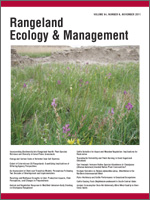Droughts characterize rangelands, yet drought research remains limited. Objectives of the study were to determine: 1) effects of the 1999–2004 drought on ranch resources, 2) how ranchers coped with the 1999–2004 drought, 3) whether ranchers have altered their preparedness for future drought, and 4) factors influencing change in preparedness. A phone and mail survey engaged a random sample of 615 ranchers providing 509 usable responses (83%). Data analysis employed descriptive statistics, directional change tests, and logistic regression. Compared to “normal” years, the 1999–2004 drought had negative effects on 75% of operations including major reductions in water supplies, forage, and cattle productivity. One quarter of respondents indicated that the drought had neutral or positive effects, usually because they had unhindered access to water or high-value hay. Only 14% of respondents felt they were adequately prepared for the 1999–2004 drought, illustrated by the high use of federal relief programs and involvement in crisis-related water development, livestock sales, and hay purchases. The “drought trap” was financial (lower revenue and higher costs), with effects well beyond 2004. By 2009 preparedness had reportedly changed. Twenty-nine percent of respondents felt they were better prepared for drought in 2009 than in 1998, a significant shift (P ≤ 0.01) in the population. Increased preparedness was significantly associated (P ≤ 0.02) with how badly a rancher was affected by the 1999–2004 drought as well as their belief that another drought is imminent. Risk-management tactics now include investment in natural-resource development and conservation plans, reductions in stocking rates, income diversification, and enrollment in insurance and federal disaster-assistance programs. Sixty-one percent of respondents said they were actively planning for future drought. The lessons of 1999–2004 have increased awareness of drought hazards among Utah ranchers, providing opportunity to enhance the financial and ecological sustainability of ranching via well-conceived risk-management initiatives.
How to translate text using browser tools
1 November 2011
Ranching and Multiyear Droughts in Utah: Production Impacts, Risk Perceptions, and Changes in Preparedness
D. Layne Coppock
ACCESS THE FULL ARTICLE
adaptive management
climate change
policy
range livestock
risk management
social-ecological systems





